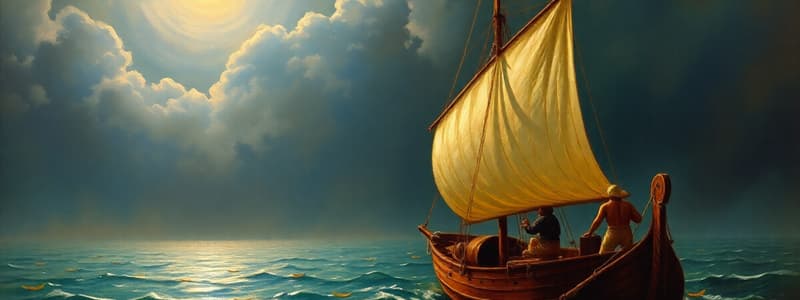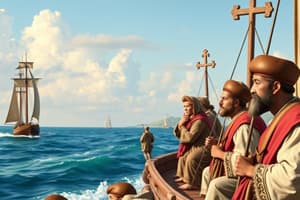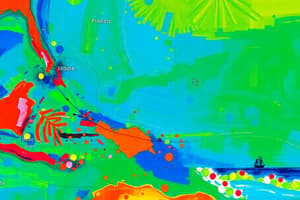Podcast
Questions and Answers
What is a crucial factor to consider when analyzing the genre of a historical source?
What is a crucial factor to consider when analyzing the genre of a historical source?
- The popularity of the source among historians
- The length of time the source has been available
- How the genre may shape its content and viewpoint (correct)
- The nature of the historical events it describes
How might the timing of a historical source's production affect its context?
How might the timing of a historical source's production affect its context?
- It determines the longevity of the source's relevance
- It can relate to and be influenced by other concurrent events (correct)
- It impacts the physical condition of the source over time
- It is irrelevant to the content of the source
What long-term impact is highlighted regarding colonialism in the Philippines?
What long-term impact is highlighted regarding colonialism in the Philippines?
- Colonialism has been forgotten over time
- The impact of colonialism continues to be felt today (correct)
- Colonialism had no effect on contemporary issues
- Colonialism primarily affected the economy, not culture
Why is it important to identify different perspectives on historical events?
Why is it important to identify different perspectives on historical events?
What should individuals do to minimize bias when interpreting historical events?
What should individuals do to minimize bias when interpreting historical events?
What was the primary objective of Magellan's voyage?
What was the primary objective of Magellan's voyage?
Who assisted Magellan by documenting the journey?
Who assisted Magellan by documenting the journey?
What type of document did Pigafetta produce after the voyage?
What type of document did Pigafetta produce after the voyage?
What is the primary focus of historical context in literature and history?
What is the primary focus of historical context in literature and history?
What does the process of contextualizing a historical source involve?
What does the process of contextualizing a historical source involve?
How many manuscript versions of Pigafetta's account survive today?
How many manuscript versions of Pigafetta's account survive today?
How does contextualizing a source increase a writer's credibility?
How does contextualizing a source increase a writer's credibility?
Why was Pigafetta's original diary significant?
Why was Pigafetta's original diary significant?
What is an essential aspect of historical context that influences the interpretation of events?
What is an essential aspect of historical context that influences the interpretation of events?
What aspects did Pigafetta aim to research during the voyage?
What aspects did Pigafetta aim to research during the voyage?
What role does the language of a historical source play in understanding its context?
What role does the language of a historical source play in understanding its context?
What notable individuals did Pigafetta present his account to upon returning to Europe?
What notable individuals did Pigafetta present his account to upon returning to Europe?
Which aspect of Pigafetta’s document is noted for being lost?
Which aspect of Pigafetta’s document is noted for being lost?
In what way does historical context enrich the understanding of memories and stories?
In what way does historical context enrich the understanding of memories and stories?
What can be a consequence of failing to consider historical context in analysis?
What can be a consequence of failing to consider historical context in analysis?
Why is it important to pay attention to the time in which a historical source was produced?
Why is it important to pay attention to the time in which a historical source was produced?
What significant event took place on April 1, 1521?
What significant event took place on April 1, 1521?
What was the name of the chief who refused to obey the King of Spain?
What was the name of the chief who refused to obey the King of Spain?
What item did Pigafetta show to the wife of Rajah Humabon?
What item did Pigafetta show to the wife of Rajah Humabon?
Who succeeded Magellan as commander of the expedition?
Who succeeded Magellan as commander of the expedition?
What was the consequence of Humabon's betrayal?
What was the consequence of Humabon's betrayal?
What was marked as the 8th of April encounter that Magellan faced?
What was marked as the 8th of April encounter that Magellan faced?
What offer did Humabon make regarding the bodies of Magellan and his crew?
What offer did Humabon make regarding the bodies of Magellan and his crew?
What was the socio-cultural aspect heavily mentioned during Magellan's voyage?
What was the socio-cultural aspect heavily mentioned during Magellan's voyage?
What color signified the noble class in the attire of the Tagalog maginoo?
What color signified the noble class in the attire of the Tagalog maginoo?
What might have led Pigafetta to view early Filipinos as treacherous?
What might have led Pigafetta to view early Filipinos as treacherous?
Which Filipino group is described as wearing simple clothes and headscarves?
Which Filipino group is described as wearing simple clothes and headscarves?
How did the Filipino's response to the Spanish expedition impact Pigafetta's view?
How did the Filipino's response to the Spanish expedition impact Pigafetta's view?
What does the term 'Binukot' refer to in the Filipino context?
What does the term 'Binukot' refer to in the Filipino context?
What was one effect of Magellan's orders to the people of Zubu regarding their idols?
What was one effect of Magellan's orders to the people of Zubu regarding their idols?
Which of the following best describes the social status of 'Visayan kadatuan'?
Which of the following best describes the social status of 'Visayan kadatuan'?
How might cultural differences between Pigafetta and Filipinos have influenced his descriptions?
How might cultural differences between Pigafetta and Filipinos have influenced his descriptions?
What religious belief contributed to Magellan's view of the early Filipinos as 'heathen'?
What religious belief contributed to Magellan's view of the early Filipinos as 'heathen'?
How did cultural differences influence Magellan's perspective on the early Filipinos?
How did cultural differences influence Magellan's perspective on the early Filipinos?
What initially characterized the behavior of the ancestors of Filipinos upon encountering Magellan?
What initially characterized the behavior of the ancestors of Filipinos upon encountering Magellan?
Which aspect of physical appearance did Pigafetta frequently remark upon in his descriptions?
Which aspect of physical appearance did Pigafetta frequently remark upon in his descriptions?
What significant action did the ancestors of the Filipinos take after their first encounter with the Spaniards?
What significant action did the ancestors of the Filipinos take after their first encounter with the Spaniards?
How did Magellan's position as part of a powerful expedition affect his view of the Filipinos?
How did Magellan's position as part of a powerful expedition affect his view of the Filipinos?
What food items were given to Magellan’s group by the early Filipinos during their first encounter?
What food items were given to Magellan’s group by the early Filipinos during their first encounter?
What term did Pigafetta use to describe the Cebuanos, highlighting their positive qualities?
What term did Pigafetta use to describe the Cebuanos, highlighting their positive qualities?
Flashcards
Historical Context
Historical Context
The social, religious, economic, and political conditions of a specific time and place.
Contextualizing a source
Contextualizing a source
Understanding a historical source by considering the time, people, and events around its creation.
Contextual Analysis
Contextual Analysis
Analyzing a source by considering the historical context in which it was created.
Importance of Historical Context
Importance of Historical Context
Signup and view all the flashcards
Source's Language
Source's Language
Signup and view all the flashcards
Contextualizing increases credibility
Contextualizing increases credibility
Signup and view all the flashcards
Historical Source
Historical Source
Signup and view all the flashcards
Adding Specificity to Reading
Adding Specificity to Reading
Signup and view all the flashcards
Genre of Source
Genre of Source
Signup and view all the flashcards
Timing of Production
Timing of Production
Signup and view all the flashcards
Colonialism's Impact
Colonialism's Impact
Signup and view all the flashcards
Different Perspectives
Different Perspectives
Signup and view all the flashcards
Own Bias
Own Bias
Signup and view all the flashcards
Magellan's arrival in the Philippines
Magellan's arrival in the Philippines
Signup and view all the flashcards
First Mass in the Philippines
First Mass in the Philippines
Signup and view all the flashcards
Meeting with Rajah Humabon
Meeting with Rajah Humabon
Signup and view all the flashcards
Blood Compact Ceremony
Blood Compact Ceremony
Signup and view all the flashcards
The Battle of Mactan
The Battle of Mactan
Signup and view all the flashcards
Magellan's Legacy
Magellan's Legacy
Signup and view all the flashcards
What happened to Magellan's body?
What happened to Magellan's body?
Signup and view all the flashcards
Juan Sebastian Elcano
Juan Sebastian Elcano
Signup and view all the flashcards
Magellan's Journey
Magellan's Journey
Signup and view all the flashcards
Pigafetta's Account
Pigafetta's Account
Signup and view all the flashcards
Pigafetta's Purpose
Pigafetta's Purpose
Signup and view all the flashcards
Why Circumnavigate?
Why Circumnavigate?
Signup and view all the flashcards
Pigafetta's Audience
Pigafetta's Audience
Signup and view all the flashcards
Pigafetta's Legacy
Pigafetta's Legacy
Signup and view all the flashcards
Pigafetta's Manuscript
Pigafetta's Manuscript
Signup and view all the flashcards
A Primary Source
A Primary Source
Signup and view all the flashcards
Pigafetta's view of early Filipinos
Pigafetta's view of early Filipinos
Signup and view all the flashcards
Cultural differences
Cultural differences
Signup and view all the flashcards
Conflict with the Spanish expedition
Conflict with the Spanish expedition
Signup and view all the flashcards
Personal biases
Personal biases
Signup and view all the flashcards
Why analyze historical accounts?
Why analyze historical accounts?
Signup and view all the flashcards
Magellan's actions in Cebu
Magellan's actions in Cebu
Signup and view all the flashcards
Early Filipino clothing
Early Filipino clothing
Signup and view all the flashcards
Early Filipino customs
Early Filipino customs
Signup and view all the flashcards
Magellan's View of Filipinos
Magellan's View of Filipinos
Signup and view all the flashcards
Animism
Animism
Signup and view all the flashcards
Pigafetta's Observations
Pigafetta's Observations
Signup and view all the flashcards
Filipino Hospitality
Filipino Hospitality
Signup and view all the flashcards
Filipino Justice & Peace
Filipino Justice & Peace
Signup and view all the flashcards
Early Filipino Encounters
Early Filipino Encounters
Signup and view all the flashcards
Cultural Exchange
Cultural Exchange
Signup and view all the flashcards
Prejudice and Misunderstanding
Prejudice and Misunderstanding
Signup and view all the flashcards
Study Notes
GEC 002 Readings in Philippine History
- Course offered at the Technological Institute of the Philippines, College of Arts, Quezon City
- First Semester, 2024-2025
Intended Learning Outcomes
- Compare Antonio Pigafetta's summary of Magellan's voyage to other contextual analyses of primary sources.
Topics
- Content/Contextual Analysis of selected primary sources
- A Brief Summary of the First Voyage Around the World by Magellan by Antonio Pigafetta
Historical Context
- Important part of life and literature
- Without context, memories, stories, and characters lose meaning
- Deals with the details surrounding an occurrence
- Includes social, religious, economic, and political conditions during a specific time and place
Contextualizing In History
- Paying attention to the people who produced the source
- Considering the time period in which they worked
- Understanding how the source's language, concepts, and terms were used in that historical context.
- Source's meaning changes over time
- Increases writer's credibility, showing willingness to understand the source and its time period
- Context adds specificity to the reading of historical events and directs attention to a particular train of thought
- Helps avoid unwanted interpretations
Questions to Consider in Doing Historical Context Analysis
- Who produced the historical source?
- What is the genre of the source?
- How might this genre shape its content and viewpoint?
- When was it produced? How does the timing relate to other events?
- How might political, social, religious, or economic events occurring at the same time have influenced the source's production?
Additional Tips
- Consider the impact of colonialism (Philippines was a colony of Spain for over 300 years and the United States for over 40 years)
- Identify different perspectives on historical events (no single, objective view of Philippine history)
- Be aware of your own biases
- Examples include the Philippine-American War, Japanese Occupation of the Philippines, and the Martial Law Years
Analyzing The Historical Context Of Pigafetta's Account Of Magellan's Arrival In The Philippines
Antonio Pigafetta
- Venetian scholar (1491-1531), from Vicenza, Italy
- Belonged to a rich family
- Studied astronomy, geography, and cartography
- Italian explorer and scholar
- Became part of Magellan's expedition under King Charles I of Spain
- Served as Ferdinand Magellan's assistant
- Kept a journal documenting everything fascinating and foreign
- One of 18 men who completed the voyage and returned to Spain in 1522, under Juan Sebastian Elcano
First Voyage Around the World
- Written by Pigafetta during the expedition (1519-1522)
- Basis for his travelogue "The First Voyage Around the World" (1525)
- Consists of 203 pages (published in Italy in 2007)
- Account of Magellan's travels, tracing the Magellan route to the Spice Islands
- An accurate ethnographic and geographic account of the first circumnavigation of the globe.
- Descriptions of people, countries, goods, and languages
- Presented copies to high personages in Europe (including Pope Clement VII and King Francis I of France)
- Original diary lost; four manuscript versions in Italian and French have survived
- Important primary historical source.
Why Was It Written?
- Discovering, researching and achieving knowledge of nautical technology, cartography, and astronomy
- Recording details and information during the expedition
- Proving the world was round and finding a western trade route to the Moluccas
- To provide a vivid description of the native Filipinos in the pre-colonial era.
A Brief Summary of the First Voyage of the World
- Magellan's encounter with local leaders, Battle of Mactan, and departure of Magellan's fleet
- Details of the pre-colonial Philippines' culture, environment, people, and culture as perceived by Europeans.
- Lapu-Lapu's refusal to obey the King of Spain.
- Arrival in Zamal (Samar) (March 17, 1521). - The island was called Humunu (Homonhon).
- Magellan and his men called it Aquada da li buoni Segnialli. - (The Watering-place of Good Signs).
- Encountering Rajah Siagu and Rajah Calambu, kings of Zuluan and Calagan
- Mass presided over by the chaplain on April 1, 1521, at Mazaua (Limasawa)
- Bringing of the cross with nails and crowns into place
- Struggle at the port of Zubu (April 8, 1521)
- Mass held with Rajah Humabon and his people on April 15, 1521.
- Magellan's death caused by Lapu-Lapu warriors in April 27, 1521
- Juan Sebastian Elcano taking over the command and departure from the Philippines.
- Summary of economic, political and socio-cultural aspects perceived by the explorers
Few of the customs and traditions mentioned
- Socio-cultural significance (Filipino culture mentioned)
- Political significance (focus on kings of islands and loyalty and superiority)
- Economic significance (man and women both responsible for work, and pre-colonial Philippines' involvement in trade)
Facts About the First Voyage Around the World
- Pigafetta's chronicle was frequently cited by pre-colonial historians
- Pigafetta's writings represent a view of a pre-colonial society.
Relevance of the Document
- Reference for many related historical works
- Evidence that the world is round, Magellan discovered Mar Pacifico
- Proved there was a way to the East by sailing West
- Opened doors between various countries
Contribution in understanding Philippine History
- Paints a somewhat accurate picture of pre-colonial Filipino life
- Helps understand Filipino life in the pre-colonial era
- Showcases the Filipinos' way of coping with the Magellan expedition
- Shows how international trade was already underway
- Important piece of Philippine History and world history
- Aids researchers and students understand Magellan's expedition
Sources
- http://ia804703.us.archive.org/34/items/firstvoyageround00piga/firstvoyageround00piga.pdf
- https://en.wikisource.org/wiki/The_First_Voyage_Round_the_World/Pigafetta%27s_Account_of_Magellan%27s_Voyage
Studying That Suits You
Use AI to generate personalized quizzes and flashcards to suit your learning preferences.




